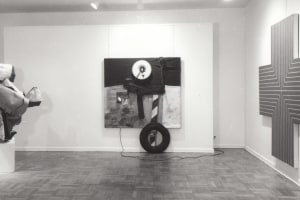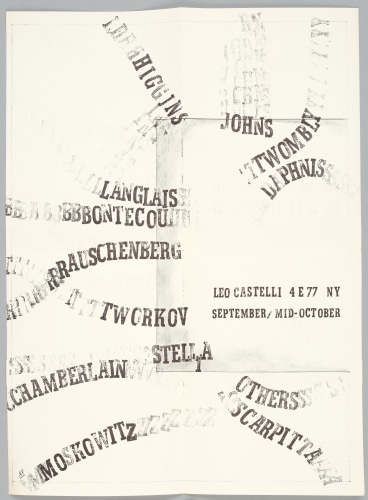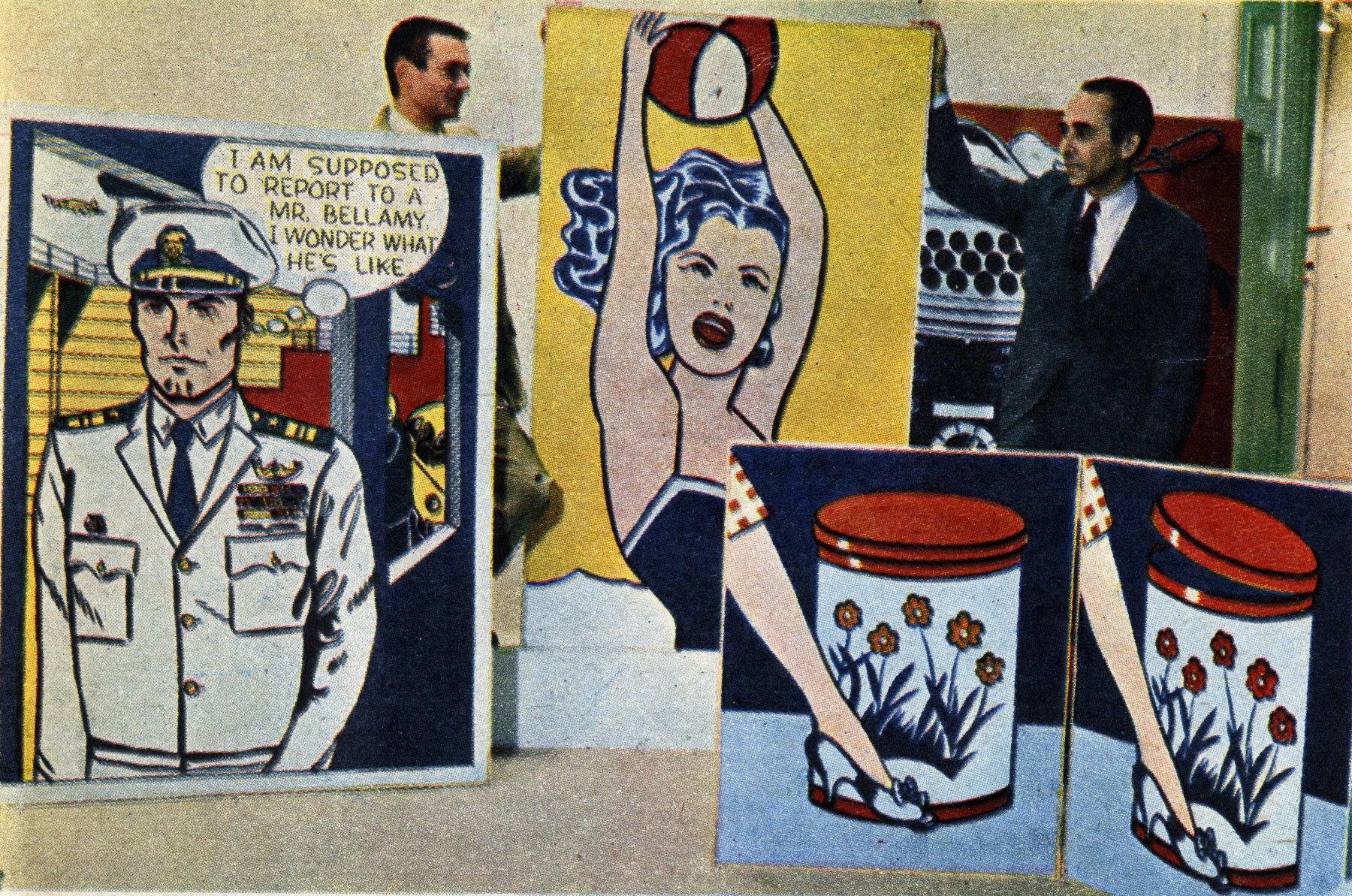

Leo Castelli Gallery, An Exhibition in Progress poster, 1961, Anita Ventura Mozley. Courtesy The Roy Lichtenstein Foundation Archives.
Roy Lichtenstein's first exhibition with Leo Castelli opened sixty-two years ago today, February 10th, 1962. However, prior to the show, in 1961, Lichtenstein exhibited "Girl with Beach Ball", now in the collection of The Museum of Modern Art, New York, in an almost undocumented show titled "An Exhibition in Progress". We invited Avis Berman to write about the groundbreaking yet unknown 1961 show. Avis Berman is a writer and art historian currently working on a biography of Roy Lichtenstein.
Roy Lichtenstein made his debut as a Pop painter at Leo Castelli Gallery with his first solo show, from February 10 – March 3, 1962.[i] Or so we thought. In truth, his art was publicly displayed there as early as September or October of 1961, in a fugitive exhibition that most people never knew took place.
Lichtenstein brought his paintings to the gallery at 4 East 77th Street, to be seen by Castelli and his lieutenant, the live-wire Ivan Karp, in September 1961. Even before Lichtenstein officially joined the gallery, one canvas briefly hung on the walls during the opening exhibition of the 1961-1962 season – amid outrage from critics, curators, and even gallery artists. Titled “An Exhibition in Progress,” the show itself was freakish, and it vanished from history. The show’s concept was new for Castelli, and its realization was not recorded with the gallery’s usual rigor, probably because the contents changed from day to day. For many years the exhibition lived on only in the memories of Castelli and Karp.[ii] With the passage of time, even Lichtenstein did not believe that it happened.
For years the only record of the show’s existence was an installation photograph of works by Robert Rauschenberg, Frank Stella, and John Chamberlain. The exhibition’s premise, Castelli explained, was inspired by the impermanency of Happenings, the artist-created performances and environments designed to be occurrences rather than objects. They had flourished since the late 1950s in downtown New York, as the realm of the emerging avant-garde. Memorable Happenings were orchestrated by Claes Oldenburg, Jim Dine, Red Grooms, and Allan Kaprow, who was a professor at Rutgers University in New Brunswick, New Jersey. Though his gallery was too small to accommodate performances, Castelli was nevertheless interested in doing something more fluid and free-spirited to inaugurate the Fall 1961 season. He planned a theme and variation show, which he named “An Exhibition in Progress” because the works of art would rotate in and out of view. “At the time, I had decided that we would do a very special, curious show,” Castelli recalled. “It was a Rauschenberg show, but it began as a group show. It was the first thing I did that seemed a little bizarre. It was in the style of Happenings.”
After the opening on September 14, 1961, a piece by Rauschenberg was added, and a piece by someone else was removed. When the eleven other artists in the show – who included Lee Bontecou, Chamberlain, Nassos Daphnis, Jasper Johns, Robert Moskowitz, Salvatore Scarpitta, Stella, Cy Twombly, and Jack Tworkov – had been replaced by Rauschenbergs, then the process was reversed. The show ran until October 22, 1961, to accommodate the switches.
However, further surprises were in store, because a recently uncovered document – a poster announcing the show – proves both the exhibition’s existence and intent. Oddly, no copy of it was preserved in the gallery’s archives.[iii] In deliberately off-register typography, the poster lists the twelve original participants, plus the intriguing addition of “Others.” The possibility of new entrants was raised, without commitment to anyone specific.
Allan Kaprow and Ivan Karp were old friends, and while the exhibition was being assembled, Kaprow asked Karp to look at the work of a colleague whose paintings were so peculiar that only Castelli could conceive of handling them. The colleague was Lichtenstein, then teaching at Douglass College, the women’s branch of Rutgers. As late as April 1961, he had been producing brushy abstractions in the shadow of de Kooning and Kline, but over the summer he started enlarging and transferring images from comic strips and commercial advertisements to canvas. These lowly pictorial sources had no business being bracketed with fine art. Even more horrifying, they were executed in the same crude style of mechanical reproduction as the original cartoons.
Possibly before “An Exhibition in Progress” opened, Lichtenstein drove to Manhattan with five to seven pictures and brought them up the stairs of the townhouse at 4 East 77th Street. At first glance, Karp thought, “You just can’t do this.” Among the original group, he said, were The Engagement Ring “and a mushy little cartoon picture” that he had the artist take back with him. (The rejected canvas was Look Mickey, which the gallery never did show. Lichtenstein hung on to it until 1991, when he and his wife Dorothy Lichtenstein donated it to the National Gallery of Art.) Yet Karp immediately recognized that Lichtenstein’s brash art radiated the shock of the new, and he was convinced that his boss would have a similar reaction. “Leo was very considerate about the possibilities of a new vision at that time,” Karp remembered. “He liked the idea of something dead-center American.” Likewise jolted by what he saw, Castelli needed time to think. Lichtenstein left a few paintings with the gallery while the two men made up their minds.
Other artists in the gallery were appalled. Karp explained that he and Castelli made the decisions about who should be shown, because, he said, “artists have a tendency to admire artists who work in their own spirit,” and as Lichtenstein’s canvases were like no one else’s imagery or spirit, “they were much despised by our own art community… by artists, critics, collectors, almost universally.” Lichtenstein’s crime was to sully the good name of art; he struck so deeply at ingrained pieties that even artists celebrated for seeking the unconventional felt contempt. “The subject matter alone,” Karp continued, “was so alien from art’s preoccupation: the idea of references to commercial things, to mindless cartoons, and to the type of treatment that Roy brought to them, seemed to be contrary to the whole sensibility of art. It was against the thinking man’s art,” by which he meant the existential angst associated with Abstract Expressionism. But one artist was enthusiastic. The sculptor Salvatore Scarpitta, who had joined Castelli in 1959, called Lichtenstein’s work “fresh and brave and new and funny and charming.”
While Karp and Castelli were mesmerized by Lichtenstein’s early Pop canvases, the other artists’ discomfort presented them with a quandary. Scarpitta understood that the premise of “An Exhibition in Progress” offered a ready-made solution. Karp remembered Scarpitta saying, “ ‘Why don’t you just give in to it? You seem to be taken up with this thing. Put one up there in the front room.’ We finally did,” despite “the fierce antagonism to the idea of … having that that kind of work in the gallery.”
Castelli chose Girl with Ball, the picture he liked best, and that was how “Rauschenberg saw a Lichtenstein painting for the first time,” said Castelli. “He was incredibly taken aback and didn’t know what to do with it. He said, ‘What is that? I really don’t understand.’ Then, he came back, since this was a show that concerned him, and looked at the painting again. ‘Well, I thought it over,’ he said. ‘I really do like it very much.’ ” Given that the exhibition revolved around Rauschenberg, his opinion had weight, and Lichtenstein’s path to wider acceptance was smoothed. Back in New Jersey, he had no idea of the internal drama swirling around his pictures. Lichtenstein’s absence from the scene may have been the primary reason why he had no memory of the event: he was not in the gallery then and thus not privy to any actions taken. He was teaching when Girl with Ball was displayed, and it might have been removed by the time he was in New York again.[iv]
As of October 1961, Castelli was formally representing Lichtenstein. By the end of the year, there were five sales, and I Can See the Whole Room! ... And There's Nobody in It!, Washing Machine, and Black Flowers went to notable collectors. Lichtenstein had been validated by the city’s best contemporary gallery, and knowledgeable tastemakers were buying his art. His one-person show, a month away, would electrify New York and propel him into art history. How ironic that such phenomenal success grew out of the behind-the-scenes doings of an exhibition that supposedly never was.
[i] See Kenneth E. Silver’s insightful essay, “Roy Lichtenstein, February 10-March 3, 1962,” posted earlier on this blog.
[ii] All quotations from Leo Castelli and Ivan Karp are drawn from Leo Castelli, interview with Paul Cummings, May 14, 1969-June 8, 1973, Archives of American Art, Smithsonian Institution (AAA) https://www.aaa.si.edu/collections/interviews/oral-history-interview-leo-castelli-12370#transcript; Barbaralee Diamonstein, “Pop Art, Money, and the Present Scene: An Interview with Roy Lichtenstein and Leo Castelli,” Partisan Review 4, no. 1 (1978) pp. 80-93; Edgar B. Howard and Seth Schneidman, Roy Lichtenstein Reflections, Checkerboard Film Foundation, 1993 https://vimeo.com/881796802/dc25952b6b?ts=1059000&share=copy; Ivan Karp, interview with Paul Cummings, March 12, 1969, AAA https://www.aaa.si.edu/collections/interviews/oral-history-interview-ivan-c-karp-11717#transcript; and Ivan Karp, interview with Avis Berman, April 15, 2004, Roy Lichtenstein Foundation Archives, New York (RLFA). At the Roy Lichtenstein Foundation, I thank Justin Brancato for sharing Castelli’s interviews with me and Allison Chomet for providing the photograph of the gallery with Lichtenstein and Castelli.
[iii] A reproduction of the poster was found by the author in November 2023 after it was sold on an auction site (https://www.liveauctioneers.com/price-result/leo-castelli-gallery-an-exhibition-in-process-poster/ ). Presumably it eluded discovery because the title was erroneously advertised as “An Exhibition in Process.”
[iv] In a 1993 interview, Lichtenstein cast doubt on the show's existence, saying that Castelli may have meant to do it but got no further than the idea. He speculated that Castelli did not know if the exhibition was "real or imagined." See Roy Lichtenstein, interview with Chris Bell, 1993, RLFA.

Roy Lichtenstein and Leo Castelli in 1961. Mr. Bellamy, 1961, Girl with Ball, 1961, Step-on Can with Leg, 1961, and Roto Broil, 1961 at the Castelli Gallery in New York, featured in the St. Louis Post-Dispatch: Sunday Pictures. Artwork © Estate of Roy Lichtenstein.